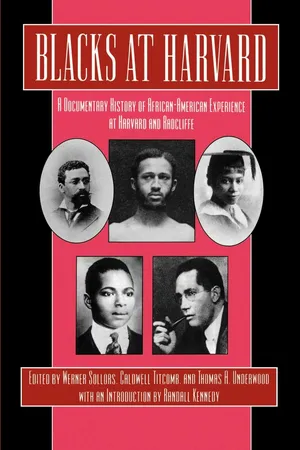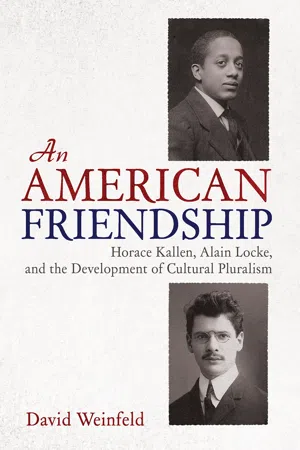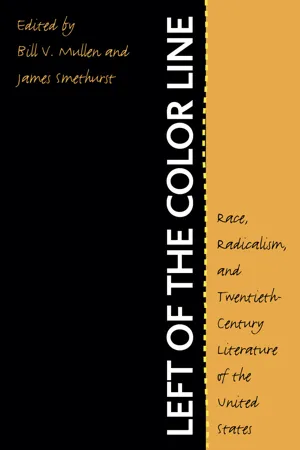History
Alain Leroy Locke
Alain Leroy Locke was a prominent African American philosopher, writer, and educator known as the "Father of the Harlem Renaissance." He played a crucial role in promoting and celebrating African American culture and art, advocating for racial equality and the recognition of African American contributions to society. Locke's influential work helped shape the cultural and intellectual landscape of the 20th century.
Written by Perlego with AI-assistance
Related key terms
5 Key excerpts on "Alain Leroy Locke"
- eBook - ePub
Black Intellectual Thought in Education
The Missing Traditions of Anna Julia Cooper, Carter G. Woodson, and Alain LeRoy Locke
- Carl A. Grant, Keffrelyn D. Brown, Anthony L. Brown(Authors)
- 2015(Publication Date)
- Routledge(Publisher)
4 TO CAPTURE THE ELUSIVEAlain Locke on Diversity, Cultural Knowledge, and Race“Too few well understood or adequately appreciated Locke”—Ralph Bunche on Alain Locke on the occasion of his memorial. (Carter & Harris, 2010) Introduction“Locke’s intellectual sojourn as a philosopher is in less need of explanation than appreciation” (Harris, 1989b, p. 10). We choose these words to open this chapter on Alain L. Locke, an extraordinary intellectual who equally claimed the role of scholar, philosopher, and aesthete.In many ways Locke was an anomalous figure for his time. He was highly educated and unusually accomplished, a point made even more poignant as a Black man in early twentieth century US. He was also a gay man, a fact that he did not hide but that was less openly acknowledged in the context of early work produced about him. In fact, some scholars have suggested that Locke’s sexuality may have played a role in the limited attention he was given as a contributor to American education thought and in his overall positioning as apolitical (Porter, 2012). Locke was most often associated with the Harlem Renaissance and the role he played in supporting and grooming the Black arts movement of the early twentieth century. For many years, this aspect of Locke’s scholarship threatened to eclipse his other scholarly areas of interest, including cultural pluralism, race, and adult education. Locke wrote extensively about the Black arts, spanning across the genres of writing, visual, music, and performance.For all of his contributions the scholarly community as a whole has paid limited attention to his work. A corpus of scholarship devoted to Alain Locke has emerged since the 1990s with much of this focused on Locke’s philosophical ideas related to values, culture, art, and race. Edited books (e.g., Carter & Harris, 2010; Harris, 1999; Molesworth, 2012a), bound collections of Locke’s lectures, essays, and reviews (Harris, 1989; Stewart, 1992), several biographies (Buck, 2005a; Cain, 2003; Harris & Molesworth, 2008), and an expansive number of journal articles and dissertations comprise this burgeoning body of work. Most of this work was produced in academic fields outside of the field of education. Aside from a few articles and dissertations written in the area of adult education, and one dissertation focused partially on Locke’s intellectual ideas related to Blackness and critical theory (Porter, 2012), virtually no scholarship exists on Locke and education, specifically critical educational thought. - eBook - ePub
Blacks at Harvard
A Documentary History of African-American Experience At Harvard and Radcliffe
- Werner Sollors, Caldwell Titcomb, Thomas A. Underwood, Randall Kennedy(Authors)
- 1993(Publication Date)
- NYU Press(Publisher)
AI AIN LOCKEAlain Leroy Locke was born to schoolteacher parents on 13 September 1886 in Philadelphia, where he attended Central High School and the Philadelphia School of Pedagogy. A member of the Harvard class of 1908, he completed his requirements in three years, and received his A.B. magna cum laude in 1907, also winning the top Bowdoin Prize for an essay on Tennyson as well as election to Phi Beta Kappa. He became the first and, until 1963, only black American to win a Rhodes scholarship to Oxford, from which he took a Litt.B. degree in 1912.In 1918 he became-after W.E.B. Du Bois and historian Carter G. Woodson—the third black recipient of a Harvard Ph.D. degree, with a dissertation in philosophy on the theory of value. He had in 1912, after a year’s study at the University of Berlin, already begun teaching English, education, and then philosophy at Howard University, where he was also instrumental in establishing a drama program, art gallery, and literary magazine. Best known for his writing on literature, he was the godfather of the so-called Harlem Renaissance of the 1920s. He also wrote extensively on the fine arts (including those of Africa) and on music (he was a trained classical pianist). At the time Du Bois termed him “by long odds the best trained man among the younger American Negroes.”In mid-career Locke acknowledged his debt to Harvard, where “I was exposed to the Golden Age of liberalism and deeply influenced by Barrett Wendell, Copeland, Briggs and Baker, shed the Tory restraints for urbanity and humanism, and under the spell of Royce, James, Palmer, and Santayana, gave up Puritan provincialism for critical-mindedness and cosmopolitanism.” Locke spoke of his “not regretted vocation—a decent livelihood teaching philosophy; and … an avocation of mid-wifery to younger Negro poets, writers and artists. … I am sure it has all been due to Harvard, at least what there has been creditable and productive.” - eBook - ePub
An American Friendship
Horace Kallen, Alain Locke, and the Development of Cultural Pluralism
- David Weinfeld(Author)
- 2022(Publication Date)
- Cornell University Press(Publisher)
The biggest difference after Locke’s death came in Kallen’s growing appreciation of the cultural achievements and potential of African Americans. In the mid-1950s and beyond, Kallen encouraged exactly what Locke had striven for his whole life, the creation of a Black high culture with roots in folklore, a culture worth preserving in a pluralist United States. He actively participated in this project in his efforts to memorialize Locke.In December 1955 Kallen wrote to Arthur Huff Fauset, Locke’s friend and chair of the Alain Locke Memorial Committee. He praised the committee’s choice of celebrated Black writer William Stanley Braithwaite to author Locke’s biography. Kallen lauded Locke’s accomplishments: “What Booker Washington had been to the Negro and the American idea in the field of material skills and material achievement, Alain Locke was in the field of the spirit.” Locke “spoke to generations of young Negroes embittered by the exclusion from equal opportunity in the arts and sciences because of their color, and coming to resent not only the un-American prejudice which maintained the exclusion, but also the color which called forth the prejudice.”17Kallen saw Black artists and intellectuals “filled with self-hatred even more than with hatred of the prejudice.” Locke’s message was “to replace self-hatred with self-respect, to accept the Negro genius as Negro and to devote their talents and powers to recovering its historic and cultural past and to renew and develop it as Negro Americans into a figure of integral strength and beauty.” Locke’s vision of the New Negro “gave a new turn, a spiritually healthier and more hopeful turn, to the aspirations and labors of the younger generations of new talent.” He contributed “a chapter of spiritual importance in the history of American culture.”18The next year, Kallen published a volume based on lectures he delivered at the University of Pennsylvania in 1954. Cultural Pluralism and the American Idea: An Essay in Social Philosophy consisted of a lengthy essay where Kallen updated cultural pluralism, followed by responses to Kallen’s essay and finally Kallen’s “reprise” to his critics. Kallen referred several times to Locke. He observed that during the “Americanization” of the South that occurred in the near century after the Civil War, Black culture began to seep into the broader American culture.19 - eBook - ePub
Left of the Color Line
Race, Radicalism, and Twentieth-Century Literature of the United States
- Bill V. Mullen, James Smethurst(Authors)
- 2012(Publication Date)
- The University of North Carolina Press(Publisher)
The Specter of Radicalism in Alain Locke's The New Negro Anthony Dawahare But fundamentally for the present the Negro is radical on race matters, conservative on others, in other words, a “forced radical,” a social protestant rather than a genuine radical. —Alain Locke, The New Negro In 1925 Alain Locke published what he hoped would be the founding anthology for the African American literary and cultural movement later called the “Harlem Renaissance.” The New Negro: An Interpretation instantly established a literary canon bound by values and interests that, to this day, direct popular views toward African American literature and life. Locke firmly believed that the literary works composing The New Negro embodied “a renewed race-spirit that consciously and proudly sets itself apart” (xxvii). Unashamed of their race and culture, his black contributors stood as ideal representatives of the “New Negro,” a post-war generation of black Americans whose cultural contributions, Locke claimed, would strengthen democracy in America. Recent anthologies of Harlem Renaissance literature continue to portray the movement as one devoted to racial expression, black pride, and American social reform. In this regard, The New Negro has been a tremendous success; its impact can still be felt. But the popularity of Locke's conception of the New Negro is largely the effect of ignoring the many other voices intensely engaged in debates over black identity, culture, and politics during the 1920s. More precisely, The New Negro should be contextualized in terms of the important postwar ideological fight between advocates of black nationalism, socialism, and American capitalism who in different ways struggled to position themselves as leaders of working-class black Americans. Through their respective cultural fronts, each faction sought to define the politics of the New Negro - eBook - ePub
- M. Cooper Harriss(Author)
- 2017(Publication Date)
- NYU Press(Publisher)
1From Harlem Renaissance to Harlem Apocalypse
Just Representations and the Epistemology of Race
On July 5 or 6, 1936, Ralph Ellison, having just completed three years’ study at Alabama’s Tuskegee Institute, arrived in New York City following the general route taken by millions of migrants from the rural South to the urban North during the interwar period. He quickly settled into Harlem. On only his second day in the city (or so the story goes), Ellison happened upon Alain Locke, whom he had met earlier at Tuskegee, in the lobby of the Harlem YMCA. Locke, who was speaking with Langston Hughes, welcomed Ellison and introduced him to Hughes before soon departing and leaving the new arrival to make an immediate impression upon the poet. Hughes quickly hired Ellison as a personal assistant and effectively fostered his transition to the city, making introductions and affording him an entrée to Harlem’s intellectual, cultural, and political opportunities.1 We begin with this tableau in the lobby of the Harlem YMCA because it frames the context of Ellison’s arrival within currents that moved Harlem’s intellectual and artistic scenes in the 1930s.By 1936 Locke and Hughes represented a pivot in the African American vanguard. A decade earlier Locke, as editor of The New Negro (1925), oversaw the documentation of emergent cultural modernization in African American life that flowered before economic crisis withered the opportunity that generated it. Hughes, already a respected poet, was fast becoming a public intellectual and man of letters, emphasizing leftist political influence in his literary and journalistic writing—most evident, perhaps, in his controversial 1935 poem “Goodbye Christ,” which encourages Jesus to “beat it on away from here” to make room for a “real” alternative: “Marx Communist Lenin Peasant Stalin Worker ME.”2 Together Locke and Hughes reflect a state of flux in African American letters as older migrants settled into new lives and newer migrants (like Ellison) entered communities that, for all of their fluidity, bore established reputations. As Ellison observes in his autobiographical essay “An Extravagance of Laughter,” Harlem proved both familiar and strange: “Familiar because of my racial and cultural identification with the majority of its people and the lingering spell that had been cast nationwide by . . . the so-called Harlem Renaissance—I viewed New Yorkers through the overlay of my Alabama experience. Contrasting the whites I encountered with those I had observed in the South, I weighed class against class and compared Southern styles with their Northern counterparts. I listened to diction and noted dress, and searched for attitudes in inflections, carriage, and manners.”3 The process of migration involves the negotiation of seemingly familiar and unfamiliar epistemes. Navigation of these poles comes with tremendous risk as individuals and communities alike reinvent themselves, applying their own imaginations and circumstances to a variety of competing templates for modernity.4
Learn about this page
Index pages curate the most relevant extracts from our library of academic textbooks. They’ve been created using an in-house natural language model (NLM), each adding context and meaning to key research topics.




